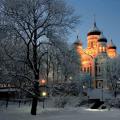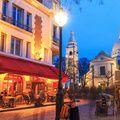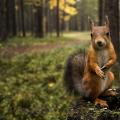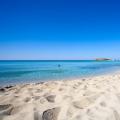What animal are they named after? Canary Islands?
In honor of dogs. Canaries are named after the islands (of which they are aborigines), and not vice versa.
The archipelago takes its name from the Latin name for the largest of the islands, which the Romans called the "Isle of Dogs" ( Insula Canada) due to the huge number of these animals on it - both wild and domesticated.
It is said that a volcano on the island of Palma, part of the archipelago, could destroy its entire western half, causing a tsunami that could cross Atlantic Ocean and after only eight hours bring down on East Coast US wave, the height of which will be up to thirty meters.
One of the traditional sports competitions of the inhabitants of the Canary Islands, where all participants compete in a sandy circle - " terrero”, called the “Canarian wrestling”. The main goal is to make the opponent touch the sand with any part of the body, except for the feet. No strikes are allowed. This sport originated among the Guanches - the first islanders who lived here before the arrival of the Spaniards.
Another attraction of the Canary Islands is the so-called "Homer whistle" ( Silbo Gomero): a method of communication used on the Canary Island of La Gomera to convey information in mountainous, ravine-cut terrain. "Speakers" in such a language are called "silbadur" ( silbadors). And although initially communication took place in the native language of the Guanches, over time, the “silbadurs” adapted to whistle in Spanish. Today, "Homer's whistle" is a required subject in local schools.
Canaries are small birds like finches. For centuries, British mining law mandated that these tiny birds be kept in mines to detect gas. Canaries were used in this role until 1986, and the corresponding article remained in the safety regulations for mining operations until 1995. The essence of this requirement was that toxic gases like carbon monoxide and methane killed birds before their concentration could pose a threat to the lives of miners. Preference was given to canaries because they sing a lot, so that the ensuing silence, when the bird falls silent, can be noticed almost immediately.
By the way, only males sing; they can also mimic the ringing of telephones and other household appliances. Yellow Tweety Pie in the famous series of cartoons "Songs with greetings" ( Looney Tunes) is also a canary.
Canaries were originally greenish-brown, but 400 years of crossbreeding led to the familiar yellow, "canary" color. No one has yet managed to breed a red canary, but a red pepper diet changes the color of the bird to orange.
London's Isle of Dogs was first named as such on a map dated 1588, possibly because the island was home to the royal kennels, though it may well be that the name was merely a derogatory term. By a strange coincidence, this is where the Canary Wharf tower (or Canary Wharf) is located.
What is the smallest dog in the world?
The world record is held by the Yorkshire Terrier. English city Blackburn, Lancashire. The dog was groomed by Arthur Marples, editor-in-chief of the English newspaper Our Dogs. His ward weighed 113 grams, height at the withers reached 6.5 cm, from the tip of the nose to the base of the tail was 9.5 cm long, lived for two years and died in 1945.
The smallest dog breed is usually considered to be the Chihuahua. However, according to the Guinness Book of World Records, today's world record for the smallest dog does not necessarily belong to a representative of this breed.
Whitney, the record breaking Yorkshire terrier, lives in Shoeburyness, Essex; its height at the withers is 7.3 cm. Chihuahua named Danka Kordak Slovakia - 18.8 cm in length and lives, you guessed it, in Slovakia.
There are over 400 dog breeds in the world today, and they all belong to the same species. Any male can cross with any female. There is no second creature in the world, which would be represented by such a wide variety of shapes and sizes. No one has yet figured out why.
The unique variety of dog breeds is primarily due to man, but the biggest mystery is that without exception, all dog breeds originate from ordinary wolves.
The Doberman Pinscher was bred by crossing German Pinschers, Rottweilers, Manchester Terriers, and possibly Pointers in as little as thirty-five years, effectively challenging Darwin's theory of species evolution, according to which such processes take thousands, if not millions of years.
For some reason unknown to us, when crossing different dog breeds, not some average creature is born, but a complete surprise. Moreover, the new "breed" retains the ability to interbreed.
Chihuahua got its name in honor of the state of the same name in Mexico: it was believed (based on the art of the Aztecs and Toltecs) that this breed has lived there since ancient times. However, none of the archaeological finds confirms such a theory, and today it is generally accepted that the animals depicted by the Indians are a kind of rodent.
Most likely, the ancestors of these dogs were brought to Mexico by the Spaniards from China, where the practice of breeding dwarf plants and animals has a rather long history.
In Mexico, Chihuahua cheese is very popular, but it is named after the state, and not after the dog.
How do dogs mate?
I wonder if other dogs consider poodles to be members of some strange religious sect?
Rita Radner
Dogs mate back-to-back, not doggy-style.
When you see one dog climbing on top of another and pumping back and forth like a pump, you are actually looking at a body of movement that is a dominance establishment procedure. Ejaculation in these cases is a rarity. That's why your neighbor's mongrel is always so actively attached to children's legs. Sex is not the main thing for her, her task is to establish her position in the pack, and for this, the smallest ones are selected first.
When mating, the dogs really start from the approach from behind, but then the male throws one hind leg so that in the end the partners turn out to be back to back. Once this has happened, the tip of the male's penis (called bulbus glandis) is filled with blood and swells, which prevents its extraction.
This situation is called "mating", because the dogs are, as it were, connected with each other. Its main goal is to minimize the leakage of semen: a classic example of "sperm competition", a way to keep the gene pool of other dogs from getting inside. After mating, there is a period of "gluing" during which ejaculation occurs, the penis becomes limp, and the dogs may separate.
It is hard for newcomers: once "bound", the poor fellows sometimes react very violently. In such cases, the "gluing" and the accompanying screeching and whining is more like a fight than a romantic relationship.
June 24, 1497 navigator John Cabot discovered Newfoundland - now part of the Canadian province of Newfoundland and Labrador. We offer you to find out how these places gave birth to popular breeds and why they are worth a visit not only for avid dog lovers.
Very picturesque island with rocky, sometimes inaccessible shores. From time to time it is shrouded in mists, which makes the landscapes extremely mysterious and enigmatic…
At first, the territory of Newfoundland was inhabited by purely Indian tribes. On June 24, 1497, an expedition of the merchant-navigator John Cabot arrived to its shores, initially with the aim of thoroughly studying the space of present-day Canada. The discovery of the island was unexpected and pleasant: the Old World just did not have enough living space, and in Newfoundland it was possible not only to live, but also to cultivate the land and cut forests, and a lot of fish were found off its coast. Deciding that it was quite possible to feed themselves here, the Europeans began to settle and develop the "newly discovered land" - this is what the name of the island looks like in English.
The "eponymous" dogs, better known in Russia as divers, appeared on this island as a result of crossing "water" breeds with mastiffs and shepherd dogs, which were brought by expeditions following Cabot. Newfoundlands helped people in the transportation of goods, rescued drowning people - and thus secured a long future for themselves.
Today, this Canadian island has excellent opportunities for exciting vacation. Local ocean landscapes attract thousands of artists, and travelers bring entire albums of stunning photographs from Newfoundland. The northern part of the island is a tundra, which only true fans of drive look into, but on the south side there are many serene forests, small rivers and lakes. National parks Terra Nova and Gros Morne are full of interesting hiking trails and delight their visitors with virgin areas of nature.
Comfortable accommodation for guests of the island is offered by inexpensive three and four star hotels.
The Labrador Peninsula, neighboring Newfoundland, also gave its name to the most popular dog breed. Remarkably, the “homeland” of the Labradors themselves is officially Newfoundland, but numerous researchers dispute this and insist that the first representatives of the breed appeared just in Labrador.
At some point in Labrador, deposits of a dark-colored igneous petrified mass, which was called labradorite, were discovered. Today, labradorite is used as a finishing material for facades and for facing the blind area of buildings. The breed of European helper dogs that settled on the peninsula at first had the same color as the stone, but over time it began to darken. And today, Labradors are found in different color variants of the exterior.
On Labrador are located unique lakes- the results of millennial melting of glaciers with the purest water. The north is famous for Lake Minto; Bienville is located in the center, and travelers admire Mistassini in the south.
A real expanse in Labrador for hunters. After obtaining a special permit on the local land, you can hunt deer, hares, martens, lynxes and foxes. The flora of this piece of Canada is also diverse: forest tundra, coniferous forests, thickets of small trees and the absence of violent human activity give Labrador a special color and purity.
Today is Friday again, and again the guests are in the studio, spinning the drum and guessing the letters. The field of miracles is on the air and here is one of the questions in the game:
There is an erroneous version that the Canary Islands are named after canary birds, although the situation is exactly the opposite. Moreover, in Latin, "Canaries" are not bird islands at all. And what? (7 letters)
Correct answer - canine(7 letters).
The Canary Islands did not get their name from the large number of canaries living there. In fact, the opposite is true - it was the birds that were named after the islands.
And the name - Canary - goes back to the Latin word canis - dog. So the Romans called the island when they encountered its inhabitants, who deified dogs. And today it is dogs that support the shield on the coat of arms of the Canary Islands.
The Canarian archipelago consists of 7 islands of volcanic origin, so the sand on the beaches is black, consisting of volcanic ash. There are beaches with yellow sand, but all of it is imported.
Canary Islands name
. An interesting fact is the fact that the title Canary Islands” in Latin means literally “dog islands”. This archipelago received such a name due to the fact that, according to the ancient scientist Pliny the Elder, on one of canary islands big dogs lived; or sea wolves. These dogs, or sea wolves, were found on the islands in large colonies. Canary Islands are an archipelago that consists of seven islands of volcanic origin.
Where are the Canary Islands
? The elite, popular among tourists, the Canary Islands are located in the Atlantic Ocean, near the northwestern coast of the nsky continent (near the following countries West Sahara and Morocco). So, knowing well enough, Where are the Canary Islands on the map? travelers and tourists can safely plan an amusing trip and rest.
What country is the Canary Islands
? Famous for the whole picturesque resort Canary Islands belong to the European Kingdom of Spain and are part of the Autonomous Communities. Canary Islands have two capitals: Las Palmas de Gran Canaria and Santa Cruz de Tenerife. However, until 1927, the city of Santa Cruz de Tenerife was the only capital canary islands- a prestigious resort region of the Kingdom of Spain.
Islands of the Canary archipelago
. In addition to the seven large inhabited islands, it also includes several small but very picturesque islets.
In the central part canary archipelago the most large island- with an area of 2057 sq. km. From the islands canary archipelago is not only the largest, but also the most densely populated island.
In the west of the archipelago are the following islands: Palma, whose area is 708 square meters. km; with an area of 378 sq. km; and the island of Hierro, area - 277 sq. km.
The island is located to the east of. is the third largest island canary archipelago. The area of the island of Gran Canaria is 1532 square meters. km.
Canarian archipelago Fuerteventura island
. To the east of the island of Gran Canaria are:, whose area is 1730 square meters. km; and the island, the area of \u200b\u200bwhich is 795 sq. km. Numerous tourists from the Russian cities of Moscow and St. Petersburg arrive on the island of Lanzarote.
Small islands of the Canary archipelago
. Of the six small islands of the Spanish resort canary archipelago only the island of Graciosa, with an area of 27 sq. km, is inhabited.
in the east canary archipelago the following small islands are located:, with an area of 10 sq. km; Lobos, 6 sq. km; Montaña Clara, with an area of only 1 sq. km; Roque del Este and Roque del Oeste. canary archipelago includes 13 islands.
It is worth clarifying that, from the point of view of geography, the famous resort Canary Islands are included in the group of islands of volcanic origin, along with such as: the Azores and the Cape Verde Islands, as well as the island of Madeira.
Canary Islands photo
Canary Islands. Coral reefs

Canary Islands. Tenerife island

Canary Islands. Picturesque landscape of Tenerife island
What animal are the Canary Islands named after? May 19th, 2013
The coat of arms of Spain depicts the Pillars of Hercules, which in ancient times the peoples of the Mediterranean considered a natural border inhabited world. There, in the west, the sun was setting. There was nothing but a formidable and dangerous desert of waters.
And on the coat of arms of Spain there is a proud motto: "Plus Ultra" - "Farther than the limit", as a memory of those times when the country owned territories located just behind the very Pillars of Hercules. Even today, Spain is a cultural metropolis for a huge Latin America almost entirely Hispanic.
So, in those proud times, ships leaving Spanish ports for America did not turn strictly to the west, which, it would seem, should have shortened the path. They sailed a southwesterly course along the coast of Africa for several days in order to land on the Canary Islands. This was done both in order to check the ship and the crew in business, and in order to replenish food and water supplies in the Canary Islands before a long ocean crossing.
Now they are planning flights to other planets. The spacecraft is first launched into near-Earth orbit, and from there it "jumps" into interplanetary space. Thus, for several centuries, the Canary Islands were something like the current orbital space station: there is already an ocean around, but it is still close to reliable land.
Today, this "bad" primarily numerous tourists. The Canary Islands are now a popular resort located in African latitudes, but with European-class service. It's nice to bask in the pool and look through its side towards the horizon of the Atlantic Ocean. It is pleasant to live in a five-star hotel surrounded by black rocks, reminiscent of the fact that a formidable volcano once erupted here. The Canary Islands are of volcanic origin, and on the island of Palma there is still active volcano. Volcanologists say that he is in a dormant state, but if he suddenly wakes up, it will not seem enough to anyone, even distant America. The eruption and accompanying earthquake will cause a thirty-meter-high tsunami wave that, moving at almost the speed of an airplane, will cover the US East Coast in eight hours.
And it’s also nice to feel abandoned to the ends of the earth. After all, the Canary Islands, which belong to Spain, are the westernmost point of the European Union. And the westernmost point in the Canaries - West Coast the islands of Hierro. In principle, it was here that some kind of triumphant, or something, arch should have been erected, and “Plus Ultra” should be written in capital letters on it.
The ancient Romans knew about the existence of these islands. They gave them the name "Canariae Insulae" - "Isles of Dogs". There were many dogs here and the dogs were large. A Roman writer wrote about it Pliny the Elder (Plinius Maior) (23 - 79) in his book Natural History. True, Pliny himself did not visit the Canary Islands, but he refers to the evidence of the Moorish king Yuba II (52 BC - 23) who made an expedition here and brought dogs from here.
So the Canary Islands are named after dogs, but the small birds that were found here in abundance were already named "canaries" after the islands.
Canaries are a local, island breed of finches, distant relatives of sparrows and siskins. In the 16th century, the Spaniards began to take them out of the island and sell them: the birds sang beautifully. For some time, canaries were a strategic commodity. To prevent them from breeding, only males were sold. Even the name of the birds was kept secret, they said that they were brought from South America. But she sewed in a bag, and you can’t hide a canary in the Canary Islands. Birds spread throughout Europe and very soon became domestic animals. By the way, the canary is one of the domestic animals that Darwin took as an example when discussing the origin of species.
The selection of canaries was carried out in two directions at once. First, they changed the color of the plumage from the original green-brown to that bright yellow, which we now call "canary". And secondly, more singing, more sonorous breeds were bred. It is interesting that the exterior of canaries was mainly dealt with in "frivolous" France, and, so to speak, with the internal content - in "solid" Germany and Tyrol. No one has yet managed to breed a blue canary. The name of the well-known song "Blue Canary" should be translated as "Sad Canary". There is also such a meaning in the English word "Blue".
In Russia, before the revolution, canaries were loved and willingly bought for fun and comfort in the house. And after the revolution, the yellow songbird, along with a harmless geranium (by the way, a good folk remedy for pathogenic microbes and mosquitoes in the house) was accused of philistinism. The proletarian poet gave her a harsh sentence:
Quicker
roll the heads of the canaries -
so that communism
was not beaten by canaries!
(V. Mayakovsky)
Then he immediately gave his beloved Lilya Brik a cage with a canary. For fun and comfort in the house, as already mentioned.
In the 16th century, canaries from the Canaries "flew" to Europe. And in the opposite direction, South America, from here, sugar cane "started" almost at the same time. The fact is that the birthplace of this useful plant is Southeast Asia and India. In the 12th century, it appeared in Europe. The Arabs brought it here and began to grow it in Egypt. The Spaniards found that this plant takes root very well in the Canaries. So by the time




